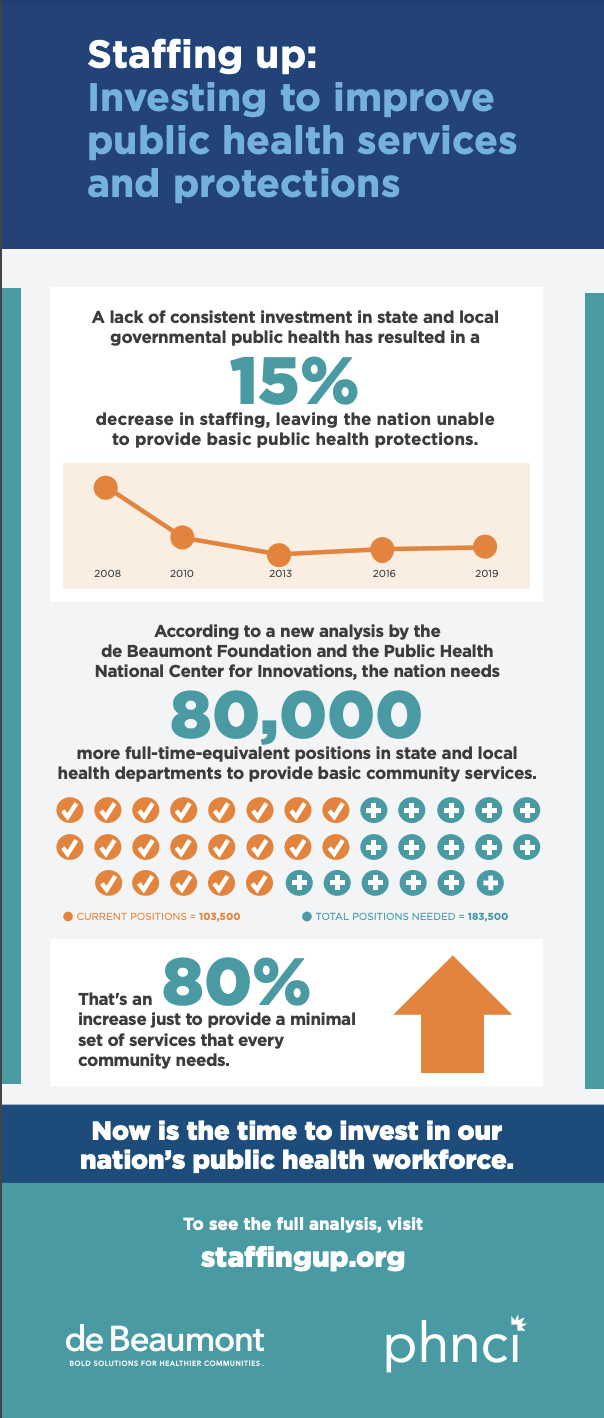State and local public health departments need an 80% increase in their workforce to provide a minimum set of public health services
According to a new analysis, state and local health departments need to hire a minimum of 80,000 more full-time equivalent positions (FTEs) — an increase of nearly 80% — to provide adequate infrastructure and a minimum package of public health services. Download the research brief, “Staffing Up: Workforce Levels Needed to Provide Basic Public Health Services.”
Despite the critical role that state and local governmental public health departments play in ensuring the safety, security, and prosperity of local communities, they have been consistently underfunded. Budget and staffing cuts have weakened the nation’s collective health and increased its vulnerability to emerging infectious disease and unchecked chronic disease. In the past decade, state and local health departments lost 15 percent of their essential staff. These cuts have limited the ability of health departments to plan for and respond to emergencies like the COVID-19 pandemic and to meet the daily needs of their communities.
To advance a thoughtful reinvestment in public health, the de Beaumont Foundation and the Public Health National Center for Innovations conducted a first-of-its-kind analysis to estimate the number of state and local public health department staff needed to deliver everyday, basic services adequately and equitably.
Based on existing shortages, approximately 54,000 of these additional FTEs should be deployed to local health departments (an increase of 70%) and 26,000 to state health departments (an increase of 80%). While all state and local departments need additional FTEs, the most acute needs are in those local health departments that serve fewer than 100,000 people.
The estimates presented in the brief encompass only the minimum number of FTEs needed for the development of infrastructure and provision of minimum services. They do not account for additional FTEs that may be temporarily required to respond to the extensive needs of pandemics or other new challenges.
Public Health Workforce Calculator
The development of the national estimate relied on modeling existing expenditure and staffing data for a sample of local and state health departments. Through a partnership between PHNCI, the de Beaumont Foundation, and the Center for State, Tribal, Local and Territorial Support at the Centers for Disease Control and Prevention to support additional data collection, analysis, and modeling, a Public Health Workforce Calculator released in fall 2022 allows health departments to determine the number and type of staff to provide sufficient levels of public health services.
Staffing Up was guided by a Steering Committee of public health leaders and a Research Advisory Committee.
Steering Committee Organizations
Members
- American Public Health Association
- Association of Public Health Laboratories
- Association of Schools and Programs of Public Health
- Association of State and Territorial Health Officials
- Big Cities Health Coalition
- Black Hawk County Public Health
- City of Longview Environmental Health Department
- Colorado School of Public Health, Anschutz Medical Campus
- Columbus Public Health
- Council of State and Territorial Epidemiologists
- de Beaumont Foundation
- Eastern Band of Cherokee Indians
- Los Angeles County Department of Public Health
- Louisiana Department of Health
- Minnesota Department of Health
- National Association of Community Health Workers
- National Association of County and City Health Officials
- National Board of Public Health Examiners
- National Indian Health Board
- Public Health Accreditation Board
- Richard M. Fairbanks School of Public Health
- Society for Public Health Education
- Trust for America’s Health
- University of Washington, School of Medicine
- Washington State Department of Health
Ex-Officio Members
- Center for State, Tribal, Local, and Territorial Support, Centers for Disease Control and Prevention
- Division of Scientific Education and Professional Development, Center for Surveillance, Epidemiology, and Laboratory Services, Centers for Disease Control and Prevention
Liaison Member
- Office of Strategy, Programs, and Partnerships, Bureau of Health Workforce Health Resources and Services Administration
Research Advisory Committee Members
- Angela Beck, University of Michigan School of Public Health
- Betty Bekemeier, University of Washington School of Nursing
- Paul Erwin, University of Alabama at Birmingham School of Public Health
- Bianca Frogner, University of Washington, School of Medicine
- Glen Mays, Colorado School of Public Health, Anschutz Medical Campus
- Mike Meit, NORC at the University of Chicago
- Jean Moore, State University of New York at Albany School of Public Health
- Jessica Owens-Young, American University
- Beth Resnick, Johns Hopkins Bloomberg School of Public Health
- Gulzar Shah, Georgia Southern University





